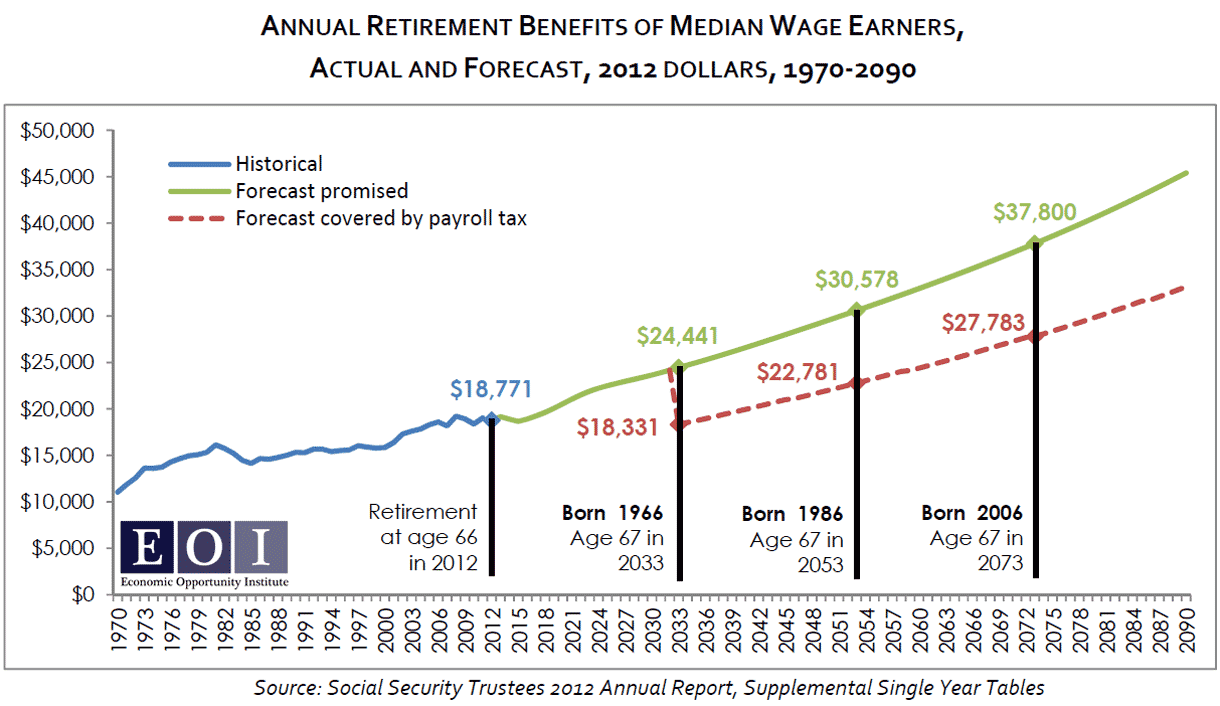Part 1 | Part Two
 Working Americans and their employers each pay 6.2% on the first $110,100 of earnings into Social Security. Those payments insure 159 million workers and their families from loss of income due to disability, premature death, or retirement. They also fund benefits averaging $1,125 monthly for 56 million Americans, including:[i]
Working Americans and their employers each pay 6.2% on the first $110,100 of earnings into Social Security. Those payments insure 159 million workers and their families from loss of income due to disability, premature death, or retirement. They also fund benefits averaging $1,125 monthly for 56 million Americans, including:[i]
- Retirees age 62+. Age for “full” benefits is gradually rising from 65 to 67.
- Disabled workers with more than 18 months work (depending on age).
- Dependents of retired, disabled, and deceased workers – children, adult disabled children, spouses, and elderly parents
In 1981, Congress adopted a plan to prepare for the retirement of the baby boomers. A key provision was to raise the payroll tax higher than the level needed to cover current benefits in order to build up the trust fund. The interest and principal of the trust fund would supplement payroll taxes during the baby boomer’s peak retirement years. The trust fund has now grown to $2.7 trillion.
Every year the Social Security actuaries and Trustees project the program’s income and expenses 75 years into the future. This requires them to make assumptions about birth and death rates, immigration, job and wage growth, and the overall economy. The actuaries conservatively predict that the U.S. economy will grow about 2% annually throughout the 21st century, rather than the 3% average rate of the 20th century.
The 2012 forecast predicts that the trust fund will be spent down as planned between 2021 and 2033. At that point payroll taxes will cover about 75% of projected benefits. One year previously, when economists were projecting a slightly faster recovery, the Trustees forecast the trust funds would last until 2036, and at that point payroll taxes would fund 77% of promised benefits. Faster than expected economic growth in future years will push those numbers up again.
Because productivity and wages usually rise faster than inflation over time, both typical workers and retirees will also have higher incomes in future decades. In fact, even under the conservative projections of the actuaries, payroll taxes in 2034 will finance about the same level of benefits as today’s retirees receive.[ii]

Tomorrow I’ll outline four steps America can take to preserve Social Security’s promise for every generation.
[i] Social Security Trustees, “The 2012 Annual Report of the Board of Trustees of the Federal Old-Age and Survivors Insurance and Federal Disability Insurance Trust Funds,” Overview, http://ssa.gov/OACT/TR/2012/index.html.
[ii] Social Security Administration, Monthly Statistical Snapshot, March 2012, http://ssa.gov/policy/docs/quickfacts/stat_snapshot/index.html?qs.
More To Read
April 17, 2024
2023-24 Impact and Gratitude Report
Reflecting on a year of progress and transition at EOI
April 12, 2024
Welcoming our New Executive Director, Rian Watt!
EOI is excited to begin its next chapter under new leadership
April 4, 2024
Is There a Valid Argument Against Cost-Free College in Washington?
Cost-free college is a meaningful investment that would change lives. What's stopping Washington from making it happen?

